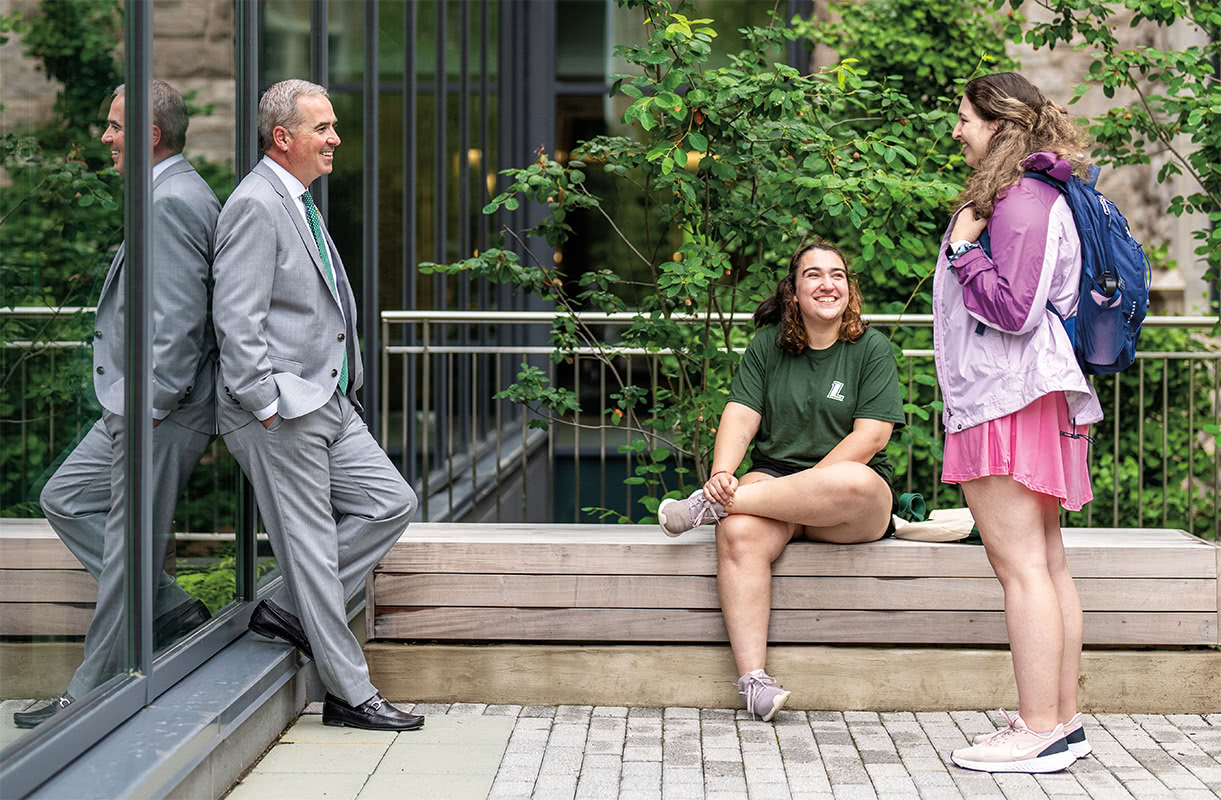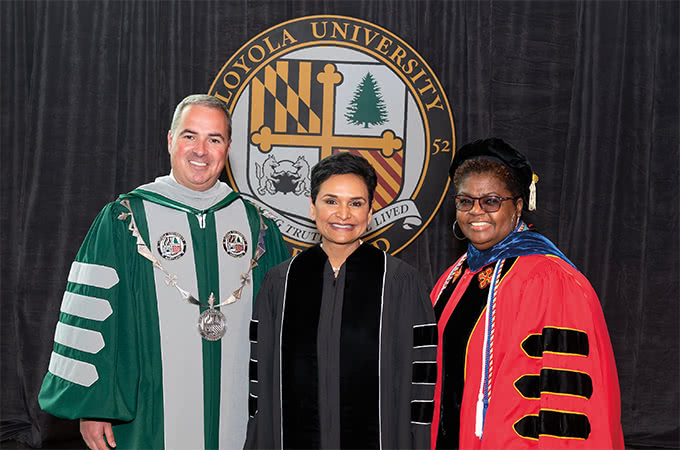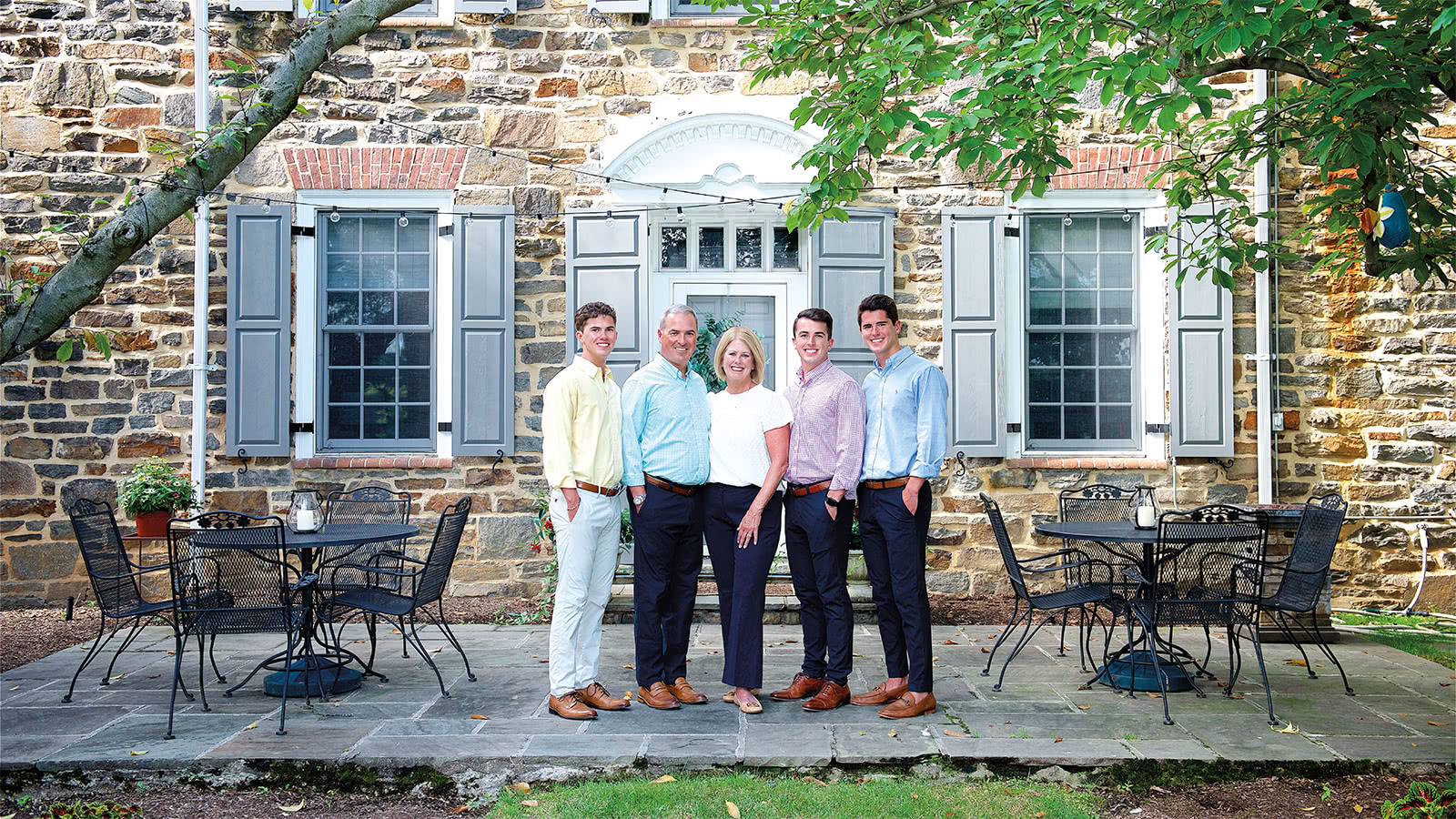
Introducing Loyola's 25th President
A New President for a Diverse and Changing World
When Terrence M. Sawyer, J.D., was growing up in Wayne, N.J., his father often spoke fondly of his years at Jesuit schools.
"My father attributed all that was good in our lives to his Jesuit education," Sawyer recalls with a laugh. "So, when I interviewed for my first job at Loyola in 1998 with (then-president) Father Harold Ridley—a real-life Jesuit who felt straight out of central casting—I was like, 'Now I get it. I see why my father was so enamored with this incredible tradition.'"
Fast forward a few decades from those dinner table conversations to last summer when—after a national search for Loyola University Maryland's 25th president—the Board of Trustees named Sawyer to the role. A familiar and highly-regarded leader in the Loyola community, Sawyer has served at the University for 24 years, including most recently as senior vice president. His tenure has been marked by reliable steadiness, a universal likeability, and, most importantly, a deep commitment to Loyola's Jesuit, Catholic identity and its academic mission.
 President Terry Sawyer enjoys speaking with students, at the Holthaus Family Plaza outside the Fernandez Center.
President Terry Sawyer enjoys speaking with students, at the Holthaus Family Plaza outside the Fernandez Center.
For Sawyer, becoming president of Loyola feels like a full-circle moment. "It's enough to make you believe that anything in the world is possible," he says.
But Sawyer is acutely aware that he ticks a few non-traditional boxes, both as a non-tenured faculty member and the first lay president in the school's 170-year history. It's a weight he feels daily—but one he says doesn't feel like a burden. "It feels like a great responsibility to ensure that our commitment to being a Catholic, Jesuit university will not wane in any way."
Putting that into action, Sawyer previously completed the Ignatian Colleagues Program, a program run by the Association of Jesuit Colleges and Universities to teach administrators and faculty the Jesuit and Catholic tradition of higher education. Sawyer also participated in an immersion experience in El Salvador, and even accompanied President Emeritus Rev. Brian F. Linnane, S.J., on a pilgrimage through Spain and Italy to walk the steps of St. Ignatius.
Imagining the Future
Cheryl Moore-Thomas, Ph.D.—Loyola's interim provost and vice president for academic affairs who served on the presidential search committee—recalls that the group was impressed by Sawyer's knowledge and connections in both Loyola and the Baltimore community. But what really stood out was Sawyer's clear enthusiasm for what Loyola is—and what it could be.
I try to create a culture where we can have honest discussions and authentic dialogue. It’s all about creating an environment where people can be their best selves.
"Terry has a unique ability to articulate his belief that Loyola can reach even higher levels of achievement. He believes in that so clearly, and he's able to communicate that in ways that make others believe it too," Moore-Thomas explains. "He is very much aware of the things he knows, and the things he doesn't know. Recognizing that, and recognizing the central mission of a Catholic, Jesuit institution, has made him really work to center academic excellence and rigor."
Moore-Thomas, who is also a professor of counselor education, has already seen this in practice during Sawyer's time as president. Recognizing the central role of faculty in the development of students and student success, she says, Sawyer has supported funding for faculty positions, including tenure-track faculty positions. He has also made it a priority to not only attend faculty assemblies and other academic events like the Undergraduate Research and Engagement Symposium—but also to actively engage with them.
"He spends time talking with students about their individual research projects, and then actually shares what he learned in those interactions at other events," she says.
Building a Community
That type of interaction and active listening is, in fact, a key tenet of Sawyer's approach to the presidency. After being sworn in as president on Jan. 1, 2022, he immediately embarked on what he calls a "conversation tour," hosting more than 500 meetings in just five months in an effort to understand the University from all perspectives.
"You learn the most through those authentic conversations," Sawyer explains. "They help you determine where we need to go, and how we are going to get there in a way that's consistent with our identity as a Catholic, Jesuit university rooted in the liberal arts."
An emphasis on open communication has long been a cornerstone of Sawyer's leadership style—and something he plans to continue as president. "I try to create a culture where we can have honest discussions and authentic dialogue," he says. "It's all about creating an environment where people can be their best selves."

 Left: President Terry Sawyer carries this handkerchief from El Salvador in his bag as an enduring reminder of his immersion trip there a few years ago. Right: When Terrence M. Sawyer, J.D., became president, parent Mickey Spillane gave him this greyhound statue, which is now proudly displayed in his home. All of Spillane’s five children graduated from Loyola, and this statue was a constant presence at the Spillane home the entire time they had a child at the University.
Left: President Terry Sawyer carries this handkerchief from El Salvador in his bag as an enduring reminder of his immersion trip there a few years ago. Right: When Terrence M. Sawyer, J.D., became president, parent Mickey Spillane gave him this greyhound statue, which is now proudly displayed in his home. All of Spillane’s five children graduated from Loyola, and this statue was a constant presence at the Spillane home the entire time they had a child at the University.
Tina Bjarekull, president emerita of the Maryland Independent College and University Association and a member of Loyola's Board of Trustees, has observed a similar commitment over her last 20 years of working with Sawyer. She believes his emphasis on relationship building and his respect for diverse perspectives makes him uniquely qualified to navigate the challenges and opportunities facing higher education right now.
"The first challenge of any leader is to ensure your constituents value your opinion and want to listen to your positions," she points out. "I've witnessed him interact with neighbors, students, faculty, administrators, presidents of institutions, and political leaders in local, state, and federal governments. Without exception, he emerges as ‘the leader.' People respect and trust him."
Sawyer's immediately-apparent approachability and sincerity also help foster that environment of open dialogue, says Jeff Lating, Ph.D., a professor of psychology and longtime friend.
"When I first met Terry, he took a genuine interest in my family and would invariably ask about them. What quickly resonated with me is that after Terry asked about my family, he would walk less than 20 feet before seamlessly engaging someone else with the same sincerity and interest," Lating says. "Building community is paramount to Terry."
Unconventional Beginnings
Sawyer worked as an attorney before getting into higher education, earning a bachelor's degree from University of Maryland, College Park, and a Juris Doctor degree from the Widener University Commonwealth Law School before practicing civil and criminal law in Baltimore City.
For me, higher education didn’t feel like work, it felt like a vocation. We all aspire to do something with our lives that brings us joy, allows us to earn a living, and allows us to contribute to something greater than ourselves.
Will Castleberry, a former college classmate and colleague, says that Sawyer's natural leadership skills were apparent from a young age. "As a young manager working for the state, Terry had a measuredness that was way beyond his years," he recalls. "You could put him in any situation, whether it was presenting to a CEO or meeting with the governor, and Terry would shine. His calmness, humor, and genuine kindness always came through."
Sawyer's affection for Loyola, meanwhile, dates back long before he was hired—to when his wife, Courtney, M.S. '93, with whom he now has three sons, was earning her M.S. in Speech-Language Pathology at the school. While visiting her on campus, Sawyer fondly remembers studying for the bar exam in McManus Theatre and unwinding by sneaking into Reitz Arena to play basketball—and sometimes getting "literally chased out by campus police," he says with a laugh.
So, in 1998, when an opportunity arose to serve as Loyola's special assistant to the president for government and community relations, he jumped at the chance. "I tell students all the time to be cautious of long-term goals that you establish for yourself—because sometimes, an incredible opportunity will reveal itself in your periphery," Sawyer says of his unexpected pivot into higher education.
"For me, higher education didn't feel like work, it felt like a vocation—which I hadn't felt in prior jobs," he says. "We all aspire to do something with our lives that brings us joy, allows us to earn a living, and allows us to contribute to something greater than ourselves. And I have this opportunity to lead an institution that means so much to me personally."
A Steady Hand
Through the years, Sawyer has become an ever-present figure at Loyola. In 2004, he was named vice president for administration, where he served as liaison to the Board of Trustees and oversaw the human resources, public safety, environmental health and safety, and parking and transportation departments. In 2015, he was promoted to vice president for advancement, before most recently serving as senior vice president, where he continued to lead advancement, along with alumni relations, career services, and marketing and communications.
Sawyer has also been an affiliate professor in Loyola's Sellinger School of Business and Management, where alumna Kat Podlovits—now a business analyst at financial services company Citadel—remembers him as "a bright and warm representation of what Loyola tries to build culturally," adding that he has always been quick to offer advice and connections to both her and her younger sister.
"He has an aptitude and desire to help who he can without wanting or needing something in return," says the 2016 graduate of Loyola. "That combination of personality plus aptitude plus agency for action is a hard trifecta to find in people—and Terry has it."
 At Loyola’s 2022 Commencement, President Terry Sawyer poses for a photo with the Commencement speaker, Anisya Fritz, Ph.D., ’85, and Cheryl Moore-Thomas, Ph.D., interim provost and vice president for academic affairs. Photo credits: Larry Canner.
At Loyola’s 2022 Commencement, President Terry Sawyer poses for a photo with the Commencement speaker, Anisya Fritz, Ph.D., ’85, and Cheryl Moore-Thomas, Ph.D., interim provost and vice president for academic affairs. Photo credits: Larry Canner.
Sawyer's impact on the school is far-reaching. He recently oversaw the University's Bright Minds, Bold Hearts campaign—which exceeded its $100 million goal—and was instrumental in developing the York Road Initiative, which supports the educational development, health, and well-being of the local neighborhood.
And most recently, Sawyer faced his biggest challenge yet: leading Loyola's response to the COVID-19 pandemic, collaborating with colleagues across the University to plan and reopen its campuses.
Tom Thompson, M.S., CCC-SLP, who has been a close family friend for decades and is now a clinical professor in Loyola's Speech-Language-Hearing Sciences Department, notes that Sawyer's leadership skills have always stood out—but never more so than during the pandemic.
"He demonstrated that he was a steady hand, and made people feel, during a very stressful time, that things were OK and that we could move forward for the students," recalls Thompson. "I'd always known him as a friend—the guy's got a great sense of humor and is a great storyteller, and is universally well-liked and respected, which as an administrator is a really unusual thing. But from a professional standpoint, the pandemic is where I really learned who he is."
Sawyer credits his former bosses and presidential predecessors, Fathers Ridley and Linnane, for helping him grow and succeed in his various roles. "Under Father Ridley, I was the kid in the room, constantly learning so much," he remembers. "And when Father Linnane got here, he really empowered me to go deeper in my Jesuit spirituality, and he trusted me with things like advancement and the COVID response—lessons I'll never forget as long as I live. I don't lose sight of the fact that as I serve as Loyola's president, I stand on their shoulders."
An "Irresistible" Future
Sawyer recalls a recent meeting with a Loyola graduate that, in his eyes, exemplifies what makes Loyola so special. The former student, who is now an investment banker on Wall Street, recalled feeling frustrated that he didn't have an Ivy League degree to automatically open certain doors.
"Now he's a managing director at a corner office at one of the most famous banks in the world," Sawyer recalls. "And he told me, ‘Now that I'm here, I realized that I have traits and skills that some of my colleagues don't have—and it's because I went to Loyola. My education allowed me to be a really good banker, sure, but also a better person, father, husband, friend, and neighbor, and ultimately a happier person.'"
As he looks to the future, Sawyer reflects on the 500-year-old pedagogical tradition of the Jesuits, which focuses on mission, teaching, and reflective preparation to help form future citizens of the world. Ultimately, he wants Loyola to prepare students for an engaged and meaningful life.
 President Terry Sawyer has settled in to his new campus home at Armiger House with wife, Courtney, and sons (left to right) Ryan, Patrick, and Ethan. Photo credits: Siobhan O'Brien.
President Terry Sawyer has settled in to his new campus home at Armiger House with wife, Courtney, and sons (left to right) Ryan, Patrick, and Ethan. Photo credits: Siobhan O'Brien.
Sawyer's vision is that the world would understand what that graduate realized: that a Loyola education is about more than just getting a job. And as the University rallies and thrives after the pandemic, Sawyer is excited to use that momentum to make Loyola what he calls "an irresistible place."
"My goal is to galvanize this community—our faculty, our staff, our administration, our students, our families, our alumni, our neighbors in Baltimore, our business and faith communities—around a shared vision that will make Loyola irresistible," he says. "Loyola can—and should be—irresistible in terms of leaders wanting to hire our students, young people wanting to come to school here, faculty, administrators, and staff who work here feeling valued and heard and wanting to stay here, and people who don't work here wanting to get a job with us."
Those of us who know Loyola recognize that there is something special about this place, this University, and this community. It's time now for us to invite others into that experience and let others fall in love with Loyola in that same way.